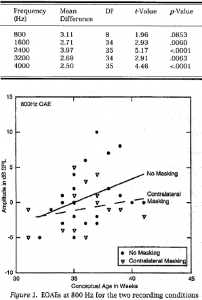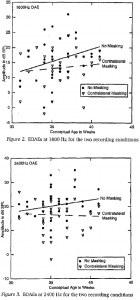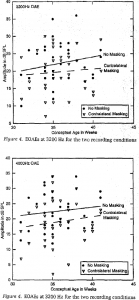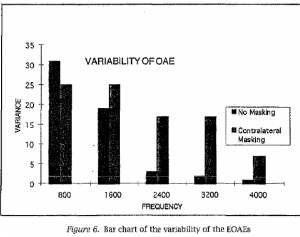Amanda K. Rasmussen, Department of Educational Psychology
Abstract
Eighteen pre-term and term infants ranging in age from 26 weeks postconception to 43 weeks post-conception were used to study developmental changes in the crossed oliviocochlear bundle (COCB) using evoked otoacoustic emissions (EOAE).
Otoacoustic emissions were recorded in both an unmasked and contralateral masking condition. Wide-band noise was presented at 60 dBSPL in the contralateral ear.
It was observed that, for the EOAE without masking, the signal-to-noise ratio of the EOAE increased.
The EOAEs in the contralaterally masked condition showed almost identical trends in both the slope, convergence and absolute confidence level values.
Our results on the changes in EOAEs in the unmasked condition are in agreement with other studies. The results of the contralateral masking condition would suggest that not only is there a maturation rate for the EOAES, but when contralateral masking is introduced the form of the maturation changes indicating different rates of maturation for the outer hair cells and the crossed oliviocochlear pathway.
Introduction
This research investigated the development of the crossed oliviocochlear bundle (COCB) on the cochlear potentials in humans. Recent findings in auditory physiology (Honrubia eta!., 1976) have shown that the inner ear may be regulated by a descending neural pathway that originates from auditory stimulation of the opposite (i.e. contralateral) ear extending to the outer hair cells of the cochlea (Brownell et a!., 1985). Techniques developed in the last several years now permit the evaluation of inner ear, or cochlear potentials, in humans non-invasively in both infants (Chuang eta!., 1993) and adults (Picton eta!., 1981). Specifically, it is now possible to record activity of outer hair cells in the cochlea by stimulating the ear with a brief transient acoustic click and recording the ‘echo’ in the ear canal which represents the activity of the outer hair cell within the cochlea (i.e. otoacoustic emission) (Kemp, 1978). Studies on adult ears have found that if a sound is presented to the contralateral ear there will be a reduction in the output of the outer hair cells thus representing the COCB. Lesion studies in animals have confirmed such findings in adult humans. Currently there is no information as to the development of this phenomenon in infants. The purpose of this research was to describe the time course of the development of the COCB in humans.
Methods
Eighteen term and pre-term neonates ranging in age from 26 weeks post-conception to 43 weeks post-conception designated as appropriate for gestational age without neurologic deficits were used in this study (i.e. ‘growing premature infants’). The neonates were tested in the NlCU at Utah Valley Regional Hospital and Medical Center. Human subject informed consent approved by both Brigham Young University and Utah Valley Regional Hospital and Medical Center was obtained. Subjects were tested at ‘bed side.’
Otoacoustlc emissions were recorded using an Otodynamics ILO 88 otoacoustic emissions unit. Wide-band noise was presented at 60 dBSPL using TDH39 earphones with a known acoustic crossover greater than 64 dBSPL in the contralateral ear. A small probe was inserted into the ear canal of the infant. Both ears were tested independently. The contralateral ear was stimulated with a constant speech spectrum noise at 60 dBSPL.
The otoacoustic emission was evaluated both in the absence and in the presence of the contralateral noise stimulus. The noise was well below any known hearing damage risk level. The amplitude of the otoacoustic emission for frequencies of 800 Hz, 1600 Hz, 2400 Hz, 3200 Hz, and 4000 Hz were measured for both the unmasked and contralateral masked conditions. The signal-to-noise ratio for these same frequencies and conditions were also measured.
Statistical analysis included means, standard deviation and ranges. Correlation coefficients were used to evaluate the changes in the otoacoustic emissions and the effects of the COCB with conceptual age.
Results
It was observed that, for the EOAE without contralateral masking, the signal-to-noise ratio for frequencies from 800 Hz to 2800 Hz increased from pre-term to term; remained constant at 3200 Hz; and showed a decrease in the signal-to-noise ratio at 4000 Hz. At about term (40 weeks) all frequencies, except for 800 Hz, had similar signal-to-noise ratios between 18 and 21 dB. The signal-to-noise ratio at 800 Hz went from -3 dB in the pre-term infant to 0 dB at term.
Similar changes with maturation were seen in the contralateral masking conditions except the signal-to-noise ratios were about 5 dB poorer. Furthermore, no effect of contralateral masking was seen prior to 30 weeks post-conception. In the contralateral masking condition EOAEs at 800 Hz were not observed and did not emerge until term.
In the unmasked condition the EOAEs in the mid- to high-frequencies the confidence level showed some minimal improvement from about 85-100% at pre-term to a slightly narrow range of 90-100% at term. The response at 1600Hz showed significant changes from a confidence level of about 45% in the preterm infant to 100% at post-term. The low frequency response at 800 Hz was extremely variable (Figure 1) and showed no consistent trend with maturation; although anecdotal observations would suggest generally a better, but still quite variable, confidence level at term and post-term (at least to 42 weeks post-conception).
Using a paired t-Test significant differences were seen in the intensity of the EOAE between the unmasked and contralateral masked condition at all frequencies except 800Hz (see Table 1). This would indicate that there is a reduction in the amplitude of the EOAE in the presence of contralateral masking noise.
Figure I is a scattergram and linear regression line for changes in the intensity of the EOAE at 800 Hz. Because of the high noise level for the low frequencies in this population 22/36 ears showed recordable EOAEs with-out masking, and 17/36 ears showed recordable EOAEs with contralateral masking. Different rates of changes are seen between the two conditions.
Figures 2 through 5 are the scattergrams and linear regressions for changes in intensity of the EOAEs for 1600 Hz, 2400 Hz, 3200 Hz and 4000 Hz. Significant differences were observed for these four frequencies between the no masking and contralateral masking condition. All figures show different slopes for maturational changes between the two conditions.
Figure 6 is a bar chart of the variability of the EOAEs. Except at 800 Hz, the variance of the EOAEs in the non-masked condition are less than in the contralateral masking condition. Also of note is the observation that the variance, for both conditions, decreases monotonically with increasing frequency.
Discussion
0ur results on the changes in EOAEs in the unmasked condition are in agreement with those made by Chuang, Gerber and Thornton (1993). The results of the contralateral masking condition would suggest that not only is there a maturation rate for the EOAEs but when masking is introduced the form of the maturation changes indicating different rates of maturation for the outer hair cell and the crossed oliviocochlear pathway.
Both the unmasked and the contralateral masked conditions show an increase in amplitude as a function of conceptual age suggesting a maturational effect. However, the slope of the unmasked condition is somewhat greater than the slope of the maturational effect in the contralateral masked condition suggesting that the maturation of the EOAE occurs at a faster rate than the maturation of the COCB. The relative flatness of the contralateral masked curves would indicate that the COCB becomes activated prior to term (i.e., 40 weeks conceptual age), and does not show a maturational rate. In fact it appears that at term the COCB is fully developed. The EOAEs in the contralaterally masked condition showed almost identical trends in both the slope, convergence and absolute confidence level values across frequencies. This would indicate that there is no effect of frequency on the COCB.
There is a significant decrease in the amplitude of the EOAE in the presence of contralateral masking and whose difference increases slightly with conceptual age. This is accounted for by the fact that the slope of the contralateral masked response is relatively flat.
The statistical differences between the slopes of the EOAE for the two conditions would suggest different rates of maturation for the EOAE and the crossed oliviocochlear pathway, with the EOAE showing a continued growth at least up to term (i.e., 40 weeks conceptual age).
The significance of these findings is that although structurally the hearing mechanism is complete at birth, the sensory and neural processes are incomplete with the neural process, as represented by the COCB, being complete prior to 40 week conceptual age. This is consistent with the observation that outer hair cell function in animals is not fully functional until post-term.
References
- Brownell, W. E., Bader, C. R., Bertrand, D., & de Ribaupierre, Y. (1985). “Evoked Mechanical Responses of Isolated Cochlear Outer Hair Cells.” Science 227:194-196.
- Chuang, S. W., Gerber, S. E., & Thornton, A. R. D. (I 993). “Evoked Otoacoustic
- Emissions in Pre term Infants.” International 1Ql!£!!i!LQL£llliii!1Ii£ Otorhinolaryngology 26:39-45.
- Honrubia, V., Strelioff, D., & Sitko. S. (1976). “Physiological Basis of Cochlear Transduction and Sensitivity.” Annuls of Otolaryngology 85:697- 71 0.
- Kemp, D. T. (1978). “Stimulated Acoustic Emissions Form Within the Auditory System.” Journal of the Acoustical Society of America 64:1386- 1391.
- Picton, T. W., Stapells, D. R., and Campbell, K. B. (1981). “Auditory Evoked Potentials from the Human Cochlea and Brainstem.” Journal of Otolaryngology (Suppl. 10), 1-41.Table 1.




